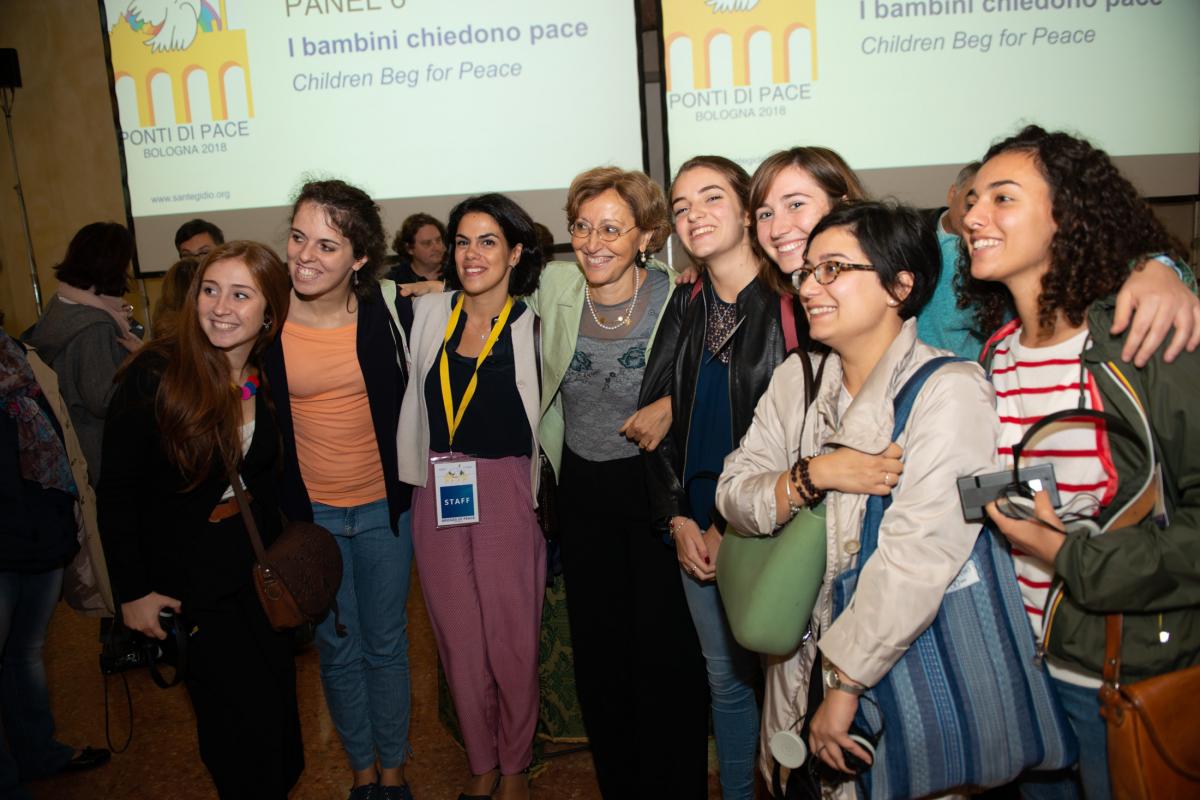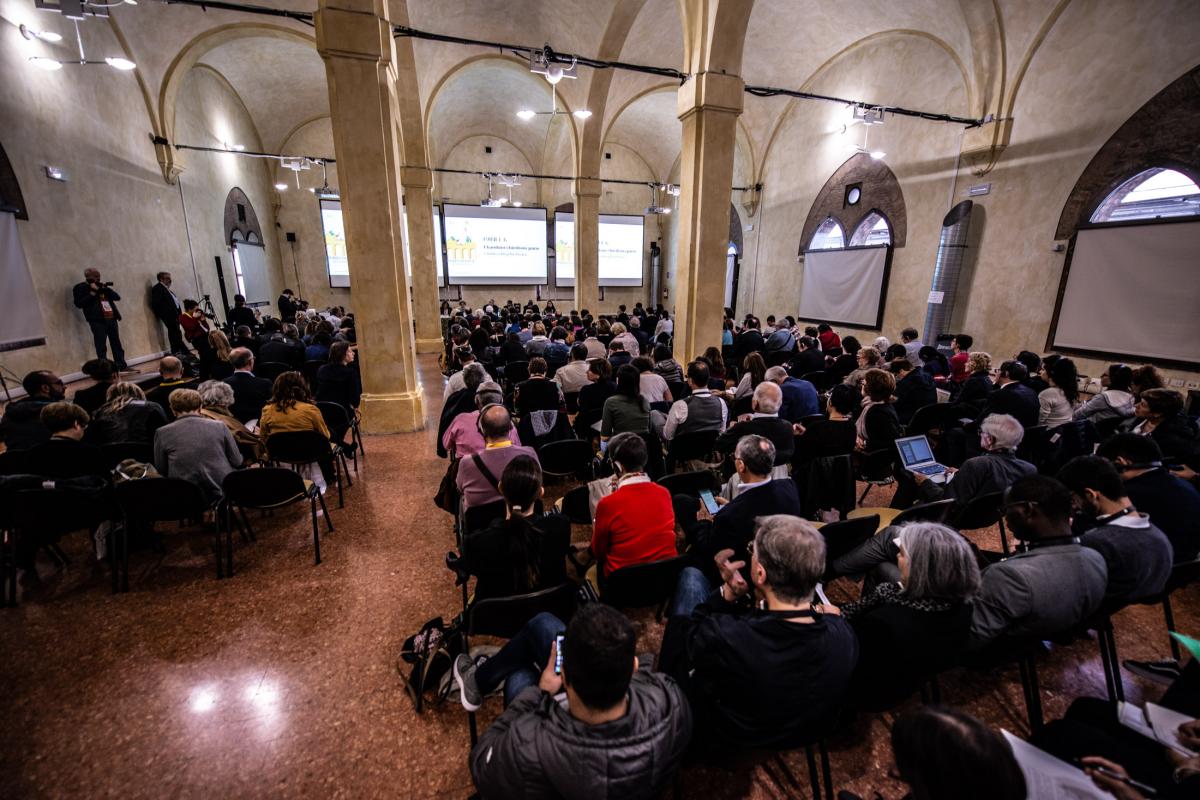
Lately, some images have impressed the collective imagination: children hit by war like the little Syrian boy photographed in an ambulance wounded at his head looking with an empty stare; or another one covered by debris in the arms of his father fleeing from the bombardments in a street of Aleppo destroyed by bombs. These children, who are emerged in war, ask for peace. Today one speaks of forever war, everlasting wars without end where nobody wins and nobody loses. Pieces of the world abandoned for years to their destiny of pain.
These children ask for peace, but what do other children do? What kind of feelings are created by these images of war spread by the media? Who sees these images pass before their eyes? There are also other children, European ones, who live in countries without war. They seem to see these images, which cause no reaction or they try not to see them.
These children and adolescents live in an environment, which Umberto Galimberti defined as “active nihilism”. An era of extreme poverty, but not due to missing consumer goods, but due to missing values; a kind of cultural crisis because our culture does not propose a promising future to our young people, as it was for their fathers, but they experience it as a thread, something unforeseeable, which cannot be dealt with.
In this cultural situation, which some define as an “era of sad passions”, the young people are victims of missing perspectives, projects, sense and emotional bonds. They often turn to pharmacological and psychological therapies, which cure the sufferings of an individual. However, evil is at the outside. It is in the cultural environment, in which a person lives, in a desert of foolishness where nothingness looms at the horizon. “Nothing motivates or stimulates, attracts or fascinates – says Galimberti. Nothing helps to get out of this absolute present, which the young people live with maximum intensity in search of dangerous situations. These situations do not make them happy, but they serve to bury their fear, which appears when the perspective is a desert”.
When culture does not give a sense to what you are living, the objective of life is missing and the future presents itself as unpredictable paralyzing initiatives and extinguishing enthusiasm. The answer to the "why" is missing and one feels rejected in a world that looks at young people not as a resource but as a problem, which leads them to sleep during the day and to live at night and to experience their absolute irrelevance. They try to exist, pursuing strong passions, showing courage and audacity, which, as teenagers, they end up expressing with reckless gestures and self-harm, putting their very survival at risk. Nowadays, it is common to read stories in the newspapers of very young people, who died trying to show their courage with a selfie. Adolescents lying on train rails, teenagers suspended on cornices, young people choked by cords tragically proving their resistance ... The web is a formidable amplifier of this desire. Are these exceptional cases? This phenomenon is very extensive and we come to know it only when the extreme challenge leads to death. There are hundreds of episodes, which, fortunately, do not have the same bitter outcomes.
They are digital natives, children and teenagers who have grown up with the Internet: bent, already at the age of 7-8 years, over their smartphones, they live with those "technological prostheses", as they have been defined, and it seems that they cannot do without them. The images that pass before their eyes on the many devices at their disposal do not seem to touch them. Violence and war are fascinating; conflict, hatred, insult are part of normality.
Social media condition their thinking and their way to gain experience is changed: what is far away seems to be close, while they drive those close to them away. They feel in touch with the whole world and restrict their existence to a small network of contacts, which locks them up in a bubble. They expose themselves in a virtual showcase so that everyone can see them in a kins of "collective monologue, where they write the same things to everyone, which can be heard by everybody". In this virtual showcase, they show what they want others to see and without aspiration for improvement, without effort, as in a photo-editing, they think they have overcome the gap between reality and idealization. When reality shows itself for what it is, without any idealization, they cannot overcome the trauma.
In the empty lives of many young people, nihilism seems to be an increasingly familiar guest. In this climate, war seems to be like a game where the boundaries with reality are blurred. As in videogames, death appears to be a transitory element, from which one can rise without consequences. At other times, violence is the most effective way to succeed. There is a desire in young people to be protagonists; especially when these young people are marginalized and considered peripheral, they seek the limelight to unload the hatred accumulated against society. Violence becomes a necessary experience, a search for strength that seems to know no limits. Why then should we be surprised that these young people facing war images do not ask for peace, nor do they stop to listen.
They seem to be without feelings. It is well known that feelings, in contrast to emotion and impulse (a stage in which the bullies often remain), is not given by nature, but is acquired through culture, as history teaches us. From primitive peoples, who narrated the legends, to our days, in which literature tells stories to make known the meaning of love, pain, boredom, despair, hope, tragedy, the meaning of life and the ineluctability of death. However, when the youngest ones do not know feelings, something terrible has happened in society. The emotional education of children no longer seems to be part of the tasks of parents, school, and society. Who explains to them which feelings they have and could live?
On the old continent, the social unease of many young people, who are alone and feel abandoned in the large urban suburbs dangerously goes along with the lack of integration of immigrants – who are still not integrated as "new Europeans". It is a reality of daily violence, which has become normal for those, who grew up in the suburbs, attending school for only a few years and without jobs. They live in neglected areas, which became dormitory quarters. Young people without opportunities, who make the immigrants the scapegoat of their difficult condition. “Italians first” one hears, competing for denied rights, that does not lead to anything good. Just a few days ago, in a town in northern Italy, access to the school canteen was allowed to the Italians "first"... The episodes of intolerance and racism against those who immigrated multiply. Anti-Semitism, Antiziganism, Islamophobia are difficult names to express a reality that, especially in the European suburbs, has become a daily experience, which is not only virtual but also real.
It is also the story of many children of immigrants, in the second or third generation, who seek radical Islam to escape from marginalization. In short, it is the reality of an unsuccessful integration in many suburbs, which have become ghettos. This situation of social conflict that has exploded in the last decades is going to add to the numerous problems caused by poverty often determining the destiny of those, who are disadvantaged and feel excluded from the rest of society.
Learning to live together is more and more the other face of peace today. Places, where you can experience peaceful coexistence in an increasingly urbanized, complex world full of conflicts, are even more necessary. Globalization seems to leave us alone in the face of tensions related to difficult coexistence, which at times is considered impossible. In this scenario, where the number of bad teachers increases, who incite conflict and hatred, we feel the need to multiply the energies to educate the young generations to respect human life, to love peace and reject the cult of violence.
At the center of our work, there is the commitment to teach to live in peace in many contexts; not only where there is war, but everywhere, especially where there are tensions and conflicts. In abandoned suburbs, the Schools of Peace - our free afternoon centers – which are run by young volunteers, are aimed at children, who have no other alternative than the streets. Studies, activities, games, trips and holidays are the vehicle of a new culture of openness to the other, to diversity, which is the prerequisite - but also the content - of an education to peace and coexistence.
This way, Sant'Egidio offers a daily experience of living together in peace, a kind of "counterculture", to the propaganda of violence and brute force. It is a perhaps less well-known commitment than the one for peace in many situations of conflict or interreligious dialogue. However, the concern to educate the young generations to peace coincides with the very beginning of the Community in 1968, when Sant’Egidio began to educate the children in the suburbs of Rome and today it has become a daily and global education involving hundreds of thousands of children in Europe, Africa, Asia and the Americas. In the Schools of Peace of Sant'Egidio, in addition to scholastic and emotional support, the children have the opportunity to learn to grow together with others without prejudice and hostility. Getting to know someone personally, without fear but with sympathy, the one, who is different, another person: the stranger, the Roma, and the poor.
The power of non-violence and sympathy for the weak is opposed to the cult of force as oppression. Meeting those, who are more fragile, is a very important element of the "method" of Sant'Egidio. A solidarity lived and experienced together with other peers educates to understand the other, to live new feelings of understanding, compassion, empathy, and affection. They experience that this immigrant boy, feared as a stranger - a virtual enemy - has the same feelings and fears along with an experience of pain that one learns to understand.
New feelings appear in lives, which became deserts because of loneliness. A young person next to a child or an adolescent next to an elderly person begins to realize that weakness is a part of life. It should not be feared or exorcised. This triggers a psychological and anthropological change. In the emotional desert, as is the life of so many young people, tenderness for a small or a weak person becomes an element of strength and empathy for the other. The way of looking at the other, who is no longer the "enemy" or the person to be removed, is reversed. You learn not to be afraid of who is different: foreign, poor, old ... In short, we get rid of the culture of the enemy and we begin to experience the culture of solidarity for those who are weaker.
To the logic of "Italians first", we answer with a new sensitivity towards the difficulties and tragedies of the earth. We begin to know the geography of the world with its tensions and its fractures. New "geopolitics" are outlined before the eyes of children and young people. It is made up of personal encounters with faces and stories through which they come to know the events in many countries. They listen attentively to Alou, a young man from Mali, who has come to Italy with a boat, talking about his escape from war and accept him as a new friend. They are no longer afraid of Yussef, a young man from Afghanistan, who traveled through Asia to find peace...
In the Schools of Peace, which are present in four continents, one feels bound in a universal "fraternity" without boundaries, which pushes one to feel like brothers. It is an enlargement of the bubble, into which the social media force them, an enlargement of horizons and views looking with sympathy. It is a globalization of solidarity, which is opposed to the globalization of indifference, of which Pope Francis has spoken so much. It is not ingenuousness to stand up against racism at the age of twelve, just as it is not to condemn those, who drive away foreigners. It is a concrete experience, which becomes an urgent necessity, when your classmate is marginalized because of color or because he is Roma.
Even if you have lived, feeling virtually close to those far way and moving away from those close to you, at the School of Peace you learn to encounter those close to you without fear and to feel close to the painful stories of those who are far away.
Learning to live together in solidarity opens the heart and the mind to understand and feel the question for peace that exists in the world today. This is why our centers for the children are called Schools of Peace, and our youth movement is called "Youth for Peace": peace is a big question to be welcomed and lived. It is a different way of looking at oneself and others. Learning to know and to deal with each other without fleeing into virtual reality and without fearing the personal encounter with those who are different, without giving space to fears.
Zygmunt Bauman said: "We are all dependent on each other and we cannot go backwards. We must understand how to integrate ourselves without increasing hostility, without separating peoples, who do not belong to the same place. How can we succeed? It is the fundamental question of our time".
The fundamental question of our age is a request for peace: learning to live together without enemies, being aware that we live as "we", trying to understand all the peoples of the earth, which is a promise for the future of the Young people







